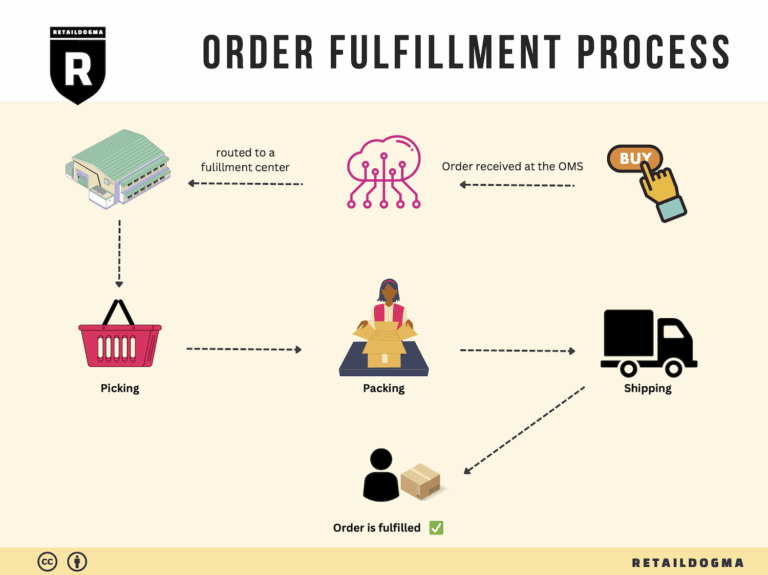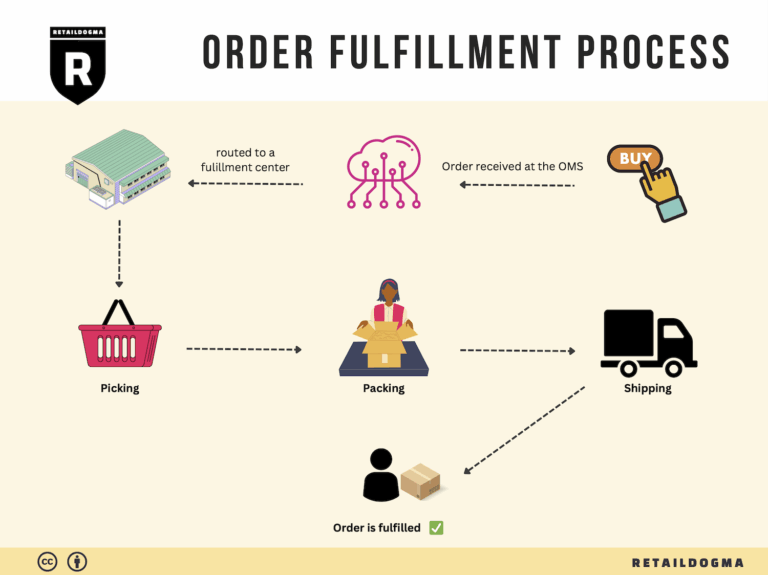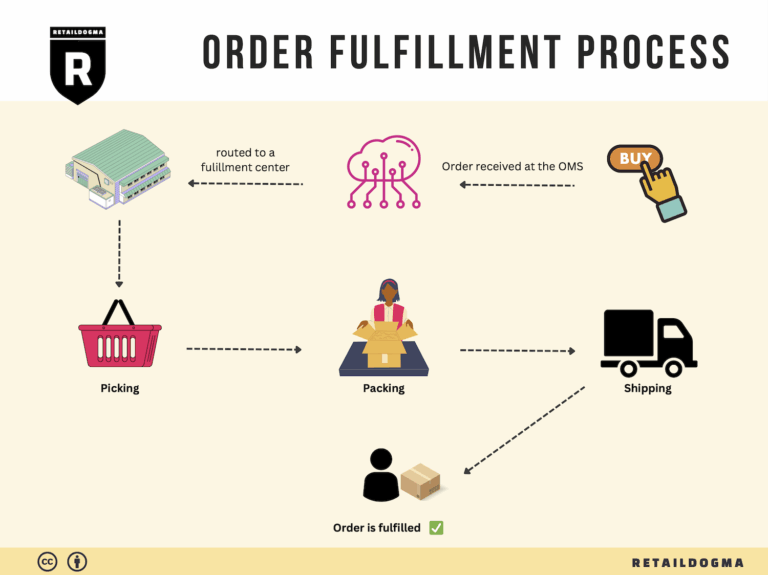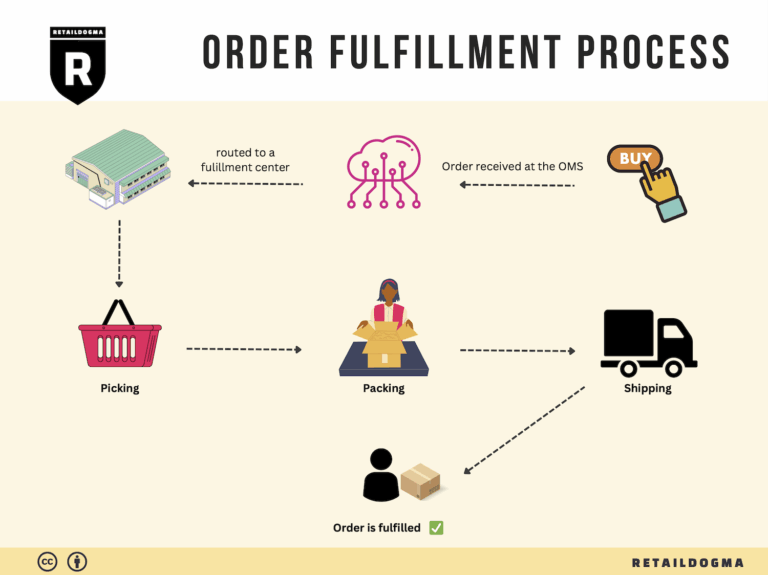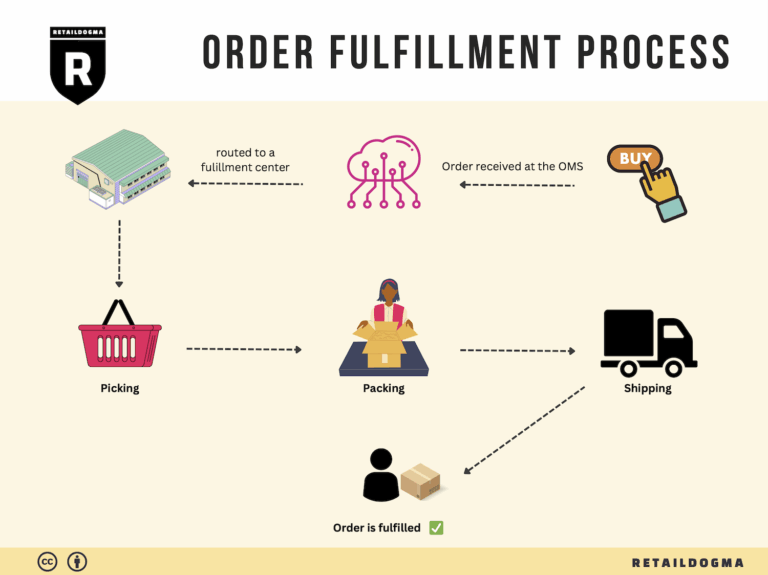What Is A Fulfillment Center? A Complete Guide (2025)
What is E-commerce Fulfillment? An Introduction for Growing Businesses
Understanding E-commerce Fulfillment: A Key to Scaling Your Business
As an e-commerce business owner, you’ve likely experienced the overwhelming challenges of packing and shipping orders. The excitement of increasing sales can quickly turn into a logistical nightmare when you find yourself buried in boxes, labels, and shipping schedules. The fulfillment process, which encompasses everything from receiving inventory to delivering products to customers, is crucial for maintaining customer satisfaction and ensuring smooth operations.
At its core, fulfillment is the process of getting a product from your warehouse or fulfillment center to your customer’s doorstep. For growing businesses, understanding the ins and outs of fulfillment is essential for scaling operations without compromising service quality. This guide aims to demystify e-commerce fulfillment, providing you with the knowledge you need to optimize your logistics.
We will explore various fulfillment models, including third-party logistics (3PL) providers and Fulfillment by Amazon (FBA). Each model has its own advantages and can significantly impact your operational efficiency, so it’s important to choose wisely based on your business needs.
Additionally, we will delve into the core services offered by fulfillment centers, such as inventory management, order processing, packing, shipping, and returns management. Understanding these services will help you identify what your business requires as you scale.
Choosing the right fulfillment partner is another critical aspect we will cover. Factors such as location, technology integration, scalability, and pricing structures will be discussed to help you make informed decisions that align with your growth strategy.
Finally, we will provide insights into pricing models used by fulfillment centers, helping you to understand the cost implications of various services and how to budget effectively for your logistics needs.
The goal of this guide is to empower you with actionable insights and strategies to make smart decisions about your logistics operations. By effectively managing fulfillment, you can enhance your customer experience, reduce operational headaches, and focus on what matters most—growing your business.
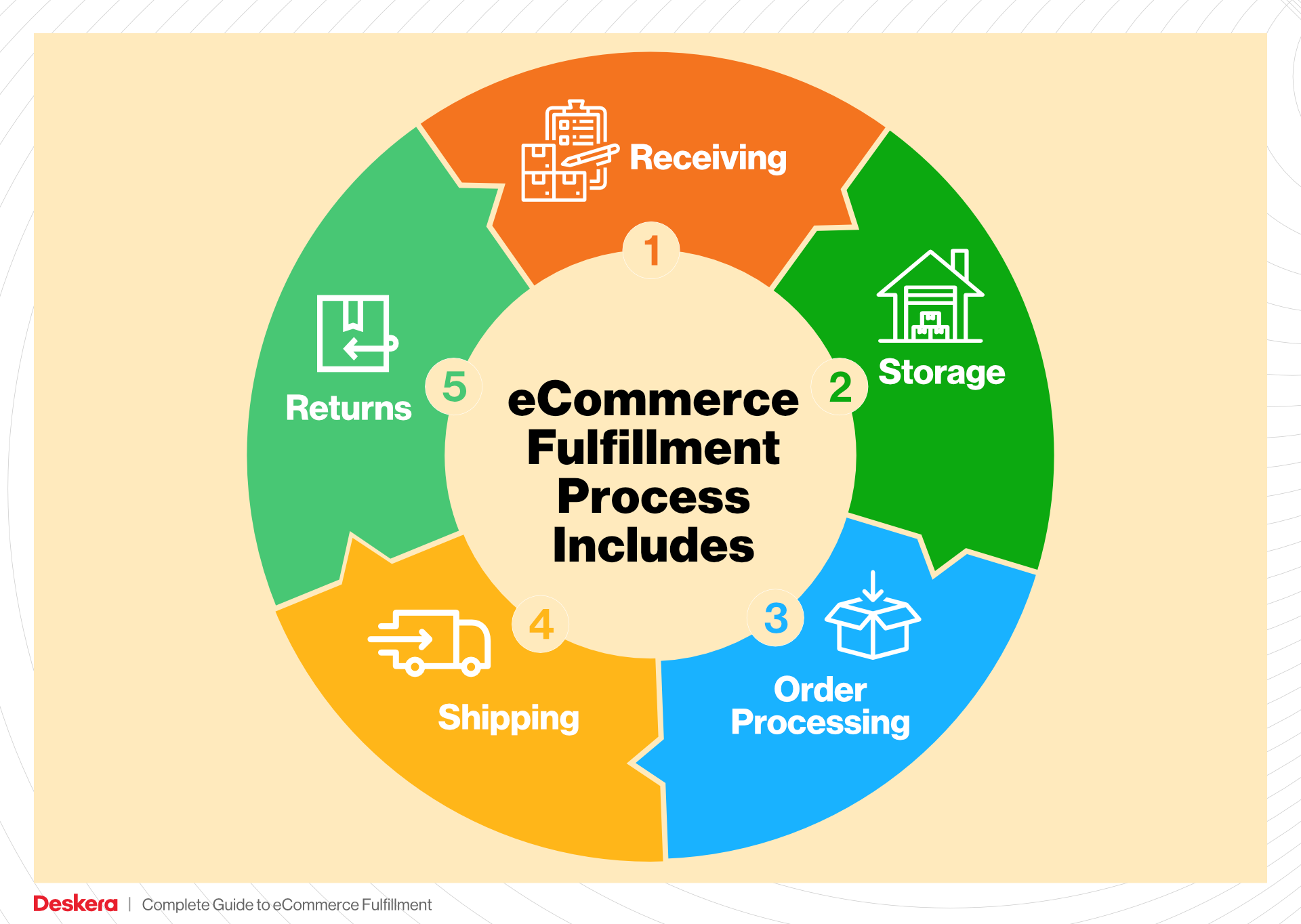
What You’ll Learn In This Guide
- What is E-commerce Fulfillment? An Introduction for Growing Businesses
- The Order Fulfillment Process: From ‘Buy’ Button to Customer’s Door
- Comparing Fulfillment Models: In-House vs. 3PL vs. Dropshipping
- A Deep Dive into Amazon FBA: Pros, Cons, and Who It’s For
- Core Services Offered by Fulfillment Centers
- How to Choose a Fulfillment Partner: A 6-Point Checklist
- Understanding Fulfillment Pricing: A Breakdown of Common Fees
- Frequently Asked Questions (FAQs) about Fulfillment
- Conclusion: Is Outsourcing Fulfillment the Right Move for Your Business?
- Important Disclaimer
The Order Fulfillment Process: From ‘Buy’ Button to Customer’s Door
1. Receiving Inventory
The order fulfillment process begins with receiving inventory at the fulfillment center. This step involves accepting shipments from suppliers, unloading them, inspecting the items for damage or discrepancies, and logging them into the inventory management system. A critical term here is SKU (Stock Keeping Unit), which uniquely identifies each product and helps track inventory levels.
This step is essential because accurate receiving ensures that inventory records reflect what is physically available. Errors at this stage can lead to stockouts or overstock situations, both of which can disrupt order fulfillment and negatively impact customer satisfaction. Efficient receiving processes can also minimize delays in getting products ready for sale, thus enhancing overall operational efficiency.
2. Warehouse Storage
After inventory is received, the next step is warehouse storage. Products are organized within the fulfillment center in designated areas, using shelving, bins, or racks to maximize space and accessibility. This organization is often supported by a Warehouse Management System (WMS), which helps track the location and quantity of products.
Effective storage solutions are crucial for maintaining an efficient order fulfillment process. Properly organized storage reduces the time it takes to locate items during the picking phase, thereby speeding up the overall fulfillment process. Moreover, optimizing warehouse layout can lead to better inventory turnover, ensuring that popular items are readily available while minimizing holding costs for less popular stock.
3. Order Picking
Once an order is placed, the fulfillment process moves to order picking. This step involves retrieving the items from storage based on the details of the order. Employees use pick lists, which are generated by the order management system (OMS), to identify the items needed for each order and their corresponding locations within the warehouse.
Order picking is a critical step because it directly affects the accuracy and speed of order fulfillment. Errors during this stage can lead to incorrect shipments, resulting in customer dissatisfaction and increased return rates. To improve efficiency, many fulfillment centers are adopting automated picking technologies, such as voice picking or pick-to-light systems, which enhance accuracy and speed by guiding workers through the picking process.
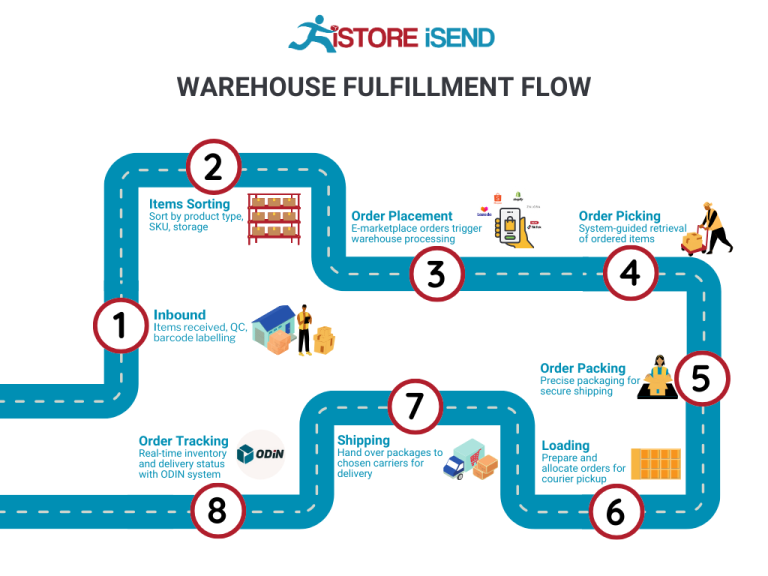
4. Order Packing
After items have been picked, they proceed to the order packing stage. Here, the selected products are prepared for shipment, which includes boxing, labeling, and ensuring that items are securely packed to prevent damage during transit. The packing station often utilizes packing slips and shipping labels generated by the OMS.
This step is significant as it ensures that the products reach customers in optimal condition. Efficient packing can also reduce shipping costs by optimizing box sizes and minimizing wasted space. Additionally, a well-packed order reflects the brand’s commitment to quality and customer care, which can enhance customer loyalty and encourage repeat purchases.
5. Shipping & Delivery
The final step in the order fulfillment process is shipping and delivery. Once orders are packed, they are handed over to shipping carriers for transport to the customer. This stage is where the effectiveness of carrier partnerships becomes evident. Businesses must choose reliable carriers and negotiate favorable shipping rates to balance cost and delivery speed.
Shipping and delivery are paramount as they represent the last touchpoint in the customer experience. Timely delivery can significantly influence customer satisfaction and retention. Moreover, businesses should monitor shipping performance metrics, such as delivery times and carrier reliability, to identify areas for improvement. Implementing tracking systems can also keep customers informed about their order status, further enhancing their experience.
In summary, understanding and optimizing each step of the order fulfillment process is crucial for e-commerce businesses looking to scale effectively. By focusing on efficient receiving, smart storage, precise picking, careful packing, and reliable shipping, businesses can improve operational efficiency and enhance customer satisfaction, ultimately driving growth and success.
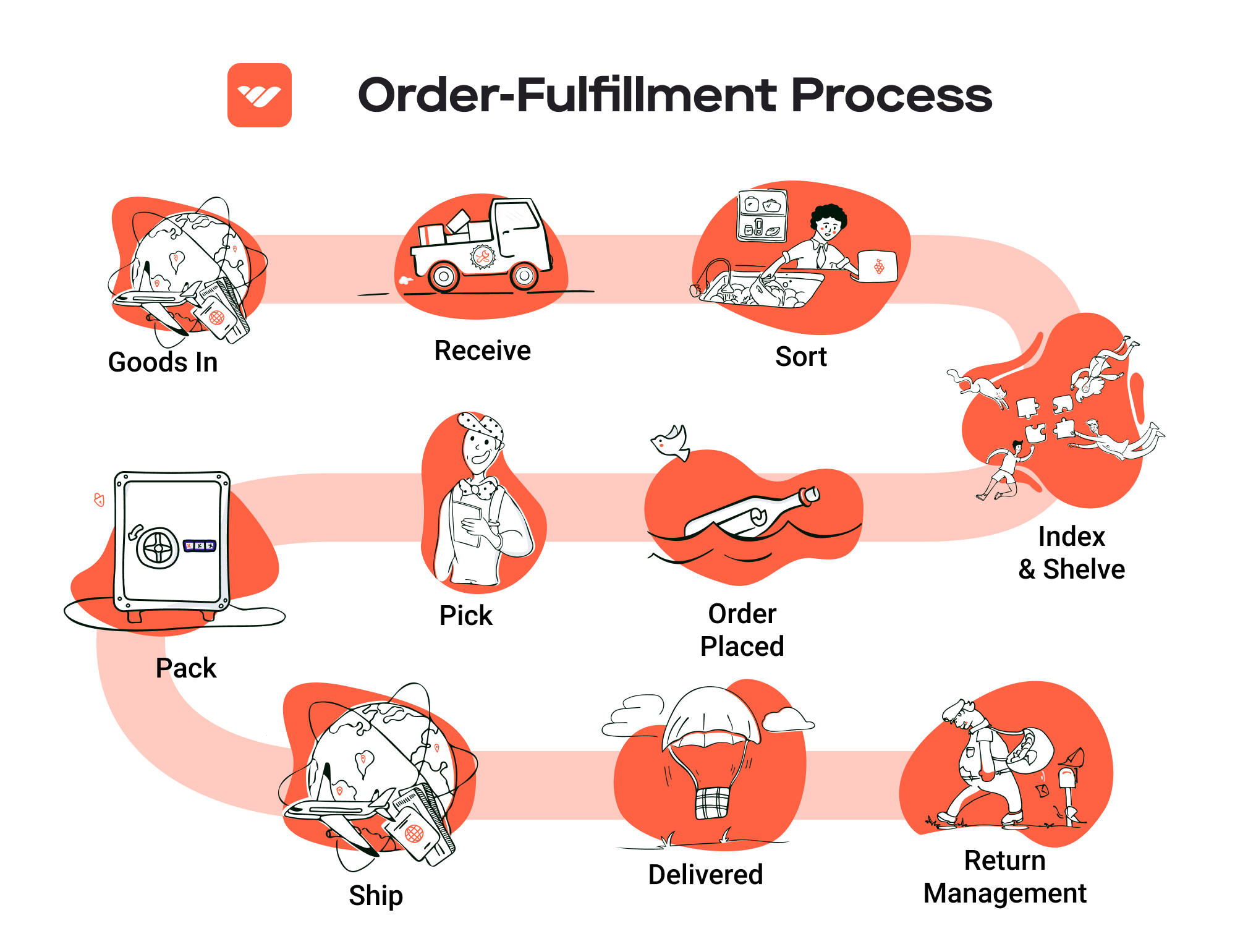
Comparing Fulfillment Models: In-House vs. 3PL vs. Dropshipping
Fulfillment Model Comparison Table
| Model | Who Handles Inventory | Best For (Business Stage) | Key Advantage | Key Disadvantage |
|---|---|---|---|---|
| In-House Fulfillment | The business itself | Established businesses with stable demand | Full control over inventory and processes | High upfront costs and operational complexity |
| Third-Party Logistics (3PL) | A third-party provider | Growing businesses and startups | Scalability and reduced overhead | Less control over fulfillment processes |
| Dropshipping | Supplier or manufacturer | Startups and small businesses | Low initial investment and risk | Lower profit margins and less control over quality |
In-House Fulfillment
In-house fulfillment involves managing all aspects of inventory storage, order processing, and shipping within the business itself. Companies that choose this model typically invest in their own warehouse space, staff, and technology to handle fulfillment tasks. This approach provides complete control over the entire fulfillment process, allowing businesses to tailor operations to their specific needs and maintain direct oversight of inventory management. It is particularly advantageous for established businesses with predictable demand, as it enables streamlined operations and potentially faster shipping times. However, the high upfront costs associated with acquiring or leasing warehouse space, hiring staff, and implementing necessary technology can be significant. Additionally, businesses must navigate the complexities of logistics management, which can be time-consuming and resource-intensive.
Third-Party Logistics (3PL)
Third-party logistics (3PL) providers offer a comprehensive solution for businesses looking to outsource their fulfillment processes. By partnering with a 3PL, companies can leverage the provider’s infrastructure, including warehousing, technology, and expertise in logistics. This model is especially beneficial for growing businesses and startups that may not have the resources or expertise to manage fulfillment in-house. The key advantage of using a 3PL is scalability; as order volumes increase, businesses can easily adjust their logistics needs without the burden of additional capital investment. However, outsourcing fulfillment means relinquishing some control over the process, which can lead to challenges in maintaining quality and consistency. Businesses must carefully select a reputable 3PL partner and establish clear communication to ensure their fulfillment operations meet customer expectations.
Dropshipping
Dropshipping is a fulfillment model where the retailer does not keep products in stock. Instead, when a customer places an order, the retailer purchases the item from a third-party supplier, who then ships it directly to the customer. This model is particularly attractive for startups and small businesses, as it requires minimal upfront investment and eliminates the need for inventory management and warehousing. Retailers can offer a wide range of products without the financial risk associated with holding stock. However, dropshipping also comes with its own set of challenges. Profit margins tend to be lower due to reliance on suppliers for pricing and shipping, and retailers have limited control over product quality and delivery times. Additionally, issues such as stock shortages and shipping delays can negatively impact customer satisfaction, making it crucial for dropshipping businesses to build strong relationships with reliable suppliers.
In conclusion, the choice of fulfillment model depends on various factors, including business size, growth stage, available resources, and customer expectations. Each model offers unique advantages and disadvantages that can significantly impact overall operational efficiency and customer satisfaction. E-commerce business owners must carefully evaluate their specific needs and market conditions to determine the most suitable fulfillment strategy for scaling their operations effectively.
A Deep Dive into Amazon FBA: Pros, Cons, and Who It’s For
Understanding Fulfillment by Amazon (FBA)
Fulfillment by Amazon (FBA) is a service provided by Amazon that allows e-commerce sellers to store their products in Amazon’s fulfillment centers. In return, Amazon takes care of storage, packaging, shipping, and customer service for these products. This service is especially beneficial for businesses looking to scale quickly without the overhead of managing their own logistics.
When a customer places an order for a product fulfilled by Amazon, the order is processed and shipped directly from Amazon’s warehouses. Sellers can also leverage Amazon’s extensive customer service and return handling, making it an attractive option for many e-commerce businesses.
How FBA Works
-
Inventory Setup: Sellers create an Amazon seller account and list their products on Amazon. They then send their inventory to Amazon’s fulfillment centers, where the products are stored until sold.
-
Order Processing: When a customer places an order, Amazon picks, packs, and ships the product on behalf of the seller. The seller has minimal involvement in this process.
-
Customer Service: Amazon manages all customer inquiries and returns, providing a seamless shopping experience for customers.
-
Fees: Sellers pay fees based on the storage space their inventory occupies and the fulfillment services provided. These fees vary depending on the size and weight of the products.
-
Reporting and Analytics: Sellers have access to detailed reports on sales, inventory levels, and performance metrics, allowing them to make informed decisions about their business.
Pros of FBA
1. Prime Eligibility
One of the most significant advantages of FBA is that it makes products eligible for Amazon Prime. Prime members tend to have higher purchasing power and are more likely to buy products with Prime shipping options. This can lead to increased visibility and sales.
2. Customer Trust
Amazon is a trusted name in e-commerce, and by using FBA, sellers can leverage this trust. Customers are more likely to purchase products that are fulfilled by Amazon due to the assurance of reliable shipping and customer service.
3. Multi-Channel Fulfillment
FBA allows sellers to fulfill orders from multiple sales channels, including their own websites and other marketplaces. This flexibility helps businesses streamline their operations and reach a broader audience without managing multiple fulfillment systems.
4. Scalability
Using FBA enables businesses to scale quickly. As order volume increases, sellers can rely on Amazon’s infrastructure to handle logistics without the need to invest in their own warehouses or fulfillment staff.
5. Simplified Logistics
FBA eliminates the complexities of shipping, inventory management, and customer service. Sellers can focus on product sourcing, marketing, and other critical business areas while Amazon handles the logistics.
Cons of FBA
1. High Fees
While FBA offers many advantages, the fees can be significant. Sellers pay for storage space, fulfillment, and additional services, which can eat into profit margins, especially for low-cost items. Understanding these costs is essential for effective pricing strategies.
2. Strict Inventory Rules
Amazon has specific guidelines regarding inventory management, including storage limits and performance metrics. Sellers must adhere to these rules to avoid penalties or account suspensions, which can be challenging for businesses that experience fluctuating demand.
3. Commingling Risks
FBA operates on a commingling model, where inventory from multiple sellers is stored together. This can lead to issues if a seller’s product is mixed with defective or counterfeit items from other sellers, potentially damaging their reputation.
4. Limited Control over Fulfillment
While FBA simplifies logistics, it also means sellers have less control over how their products are stored, packaged, and shipped. This lack of control can be concerning for brands that prioritize specific packaging or shipping methods.
5. Dependency on Amazon
Relying on FBA means that businesses are heavily dependent on Amazon’s policies, changes in algorithms, and overall marketplace conditions. Any changes made by Amazon can directly impact a seller’s business operations and profitability.
Who is FBA Best For?
Fulfillment by Amazon is particularly well-suited for:
- Small to Medium-Sized Businesses: Companies looking to expand their reach without investing heavily in logistics.
- Brands with High Sales Volume: Sellers with a consistent sales volume can benefit from the efficiency and scalability of FBA.
- E-commerce Entrepreneurs: Those who want to focus on product development and marketing rather than operational logistics.
- Businesses with Seasonal Demand: Companies that experience fluctuating demand can leverage FBA to manage inventory more effectively without committing to long-term storage solutions.
- Multi-Channel Sellers: Businesses that sell on various platforms can use FBA to fulfill orders from multiple sales channels seamlessly.
In conclusion, FBA can be a powerful tool for e-commerce sellers looking to streamline their operations and enhance customer experience. However, it’s essential for businesses to carefully consider the associated costs and limitations to determine if it aligns with their overall strategy for growth.
Core Services Offered by Fulfillment Centers
Inventory Management & Warehousing
Inventory management and warehousing are foundational services provided by fulfillment centers. This service involves the systematic tracking and storage of products, ensuring that businesses have the right amount of stock available to meet customer demand without overstocking or facing stockouts.
Fulfillment centers utilize advanced inventory management systems (IMS) that automate the tracking of stock levels, sales trends, and reorder points. These systems help e-commerce businesses maintain optimal inventory levels, reducing the costs associated with excess inventory while ensuring that popular items are always in stock.
The benefits of effective inventory management include:
- Cost Efficiency: By optimizing stock levels, businesses can reduce warehousing costs and avoid the pitfalls of overstocking, such as waste or markdowns on unsold goods.
- Enhanced Customer Satisfaction: Accurate inventory tracking ensures that orders can be fulfilled promptly, leading to faster delivery times and increased customer satisfaction.
- Scalability: As businesses grow, effective inventory management allows for seamless scaling, accommodating increased order volumes without the chaos of managing untracked inventory.
Pick and Pack Services
Pick and pack services are crucial for order fulfillment in e-commerce. This process involves retrieving items from storage (picking) and preparing them for shipment (packing). Fulfillment centers employ various technologies and methodologies, such as barcode scanning and automated picking systems, to streamline this process.
The benefits of efficient pick and pack services include:
- Speed: A well-organized pick and pack operation can significantly reduce the time it takes to fulfill orders. This is especially important during peak seasons when order volumes spike.
- Accuracy: Automated systems reduce the likelihood of human error, ensuring that customers receive the correct items. This not only minimizes returns but also enhances customer trust.
- Cost-Effectiveness: By optimizing the picking and packing process, fulfillment centers can lower labor costs and improve operational efficiency, ultimately passing savings on to e-commerce businesses.
Kitting and Assembly
Kitting and assembly services involve combining individual items into ready-to-ship kits or bundles, tailored to specific customer orders. This service is particularly beneficial for businesses offering subscription boxes, promotional bundles, or customized products.
The advantages of kitting and assembly include:
- Increased Efficiency: Kitting allows for bulk preparation of items, which can speed up the packing process and reduce labor costs associated with individual item packing.
- Enhanced Customer Experience: Offering pre-assembled kits can simplify the purchasing process for customers, making it easier for them to buy multiple related items without extra effort.
- Cost Savings on Shipping: Bundling items can lead to lower shipping costs per item, as shipping carriers often charge based on weight and size. This can make it more economical for businesses to send out packages.
Returns Management (Reverse Logistics)
Returns management, often referred to as reverse logistics, is a critical service provided by fulfillment centers. This involves handling the process of receiving, inspecting, and processing returned items. A well-structured returns management system can turn potential losses into opportunities for customer retention and satisfaction.
The benefits of effective returns management include:
- Improved Customer Trust: A seamless returns process can enhance customer loyalty, as buyers are more likely to purchase from businesses that make returns easy and hassle-free.
- Insight into Product Issues: Analyzing return data can provide valuable insights into product quality and customer preferences, allowing businesses to make informed decisions about inventory and product development.
- Cost Recovery: Efficient returns management can help businesses recover value from returned items, whether through restocking, refurbishing, or reselling items at a discount.
In conclusion, partnering with a fulfillment center that offers robust inventory management, efficient pick and pack services, kitting and assembly capabilities, and effective returns management can significantly enhance an e-commerce business’s operational efficiency. These core services not only streamline logistics but also improve customer satisfaction and support growth, making them essential for scaling businesses in the competitive e-commerce landscape.
How to Choose a Fulfillment Partner: A 6-Point Checklist
Location & Warehouse Network
The geographic location of your fulfillment partner’s warehouses can significantly impact shipping times and costs. A well-distributed network of fulfillment centers allows for quicker delivery to your customers, which is crucial in today’s fast-paced e-commerce environment.
Questions to Ask:
– Where are your fulfillment centers located, and how does this impact shipping times to my target markets?
– What is your strategy for expanding your warehouse network, and how often do you open new locations?
– Can you provide insights into your shipping rates based on your warehouse locations?
Technology & Integrations
In an increasingly digital world, the technology used by your fulfillment partner can either facilitate or hinder your operations. A robust technology stack ensures efficient order processing, real-time inventory management, and seamless integration with your existing e-commerce platforms.
Questions to Ask:
– What order management system (OMS) and warehouse management system (WMS) do you use?
– Can your systems integrate with my e-commerce platform (e.g., Shopify, WooCommerce, Amazon)?
– Do you offer automated inventory tracking and reporting tools to help me monitor stock levels?
Specializations (e.g., cold storage, oversized items)
Depending on your product types, you may require specific services such as cold storage for perishable items or specialized handling for oversized goods. Choosing a partner with the right expertise can mitigate risks and enhance service quality.
Questions to Ask:
– Do you have specialized facilities for handling my product type (e.g., temperature-controlled environments)?
– What experience do you have with my industry or product category?
– How do you ensure compliance with regulations specific to my product type (e.g., food safety standards)?
Scalability & Capacity
As your business grows, your fulfillment needs will change. It is essential to partner with a 3PL that can scale alongside you without compromising service quality. Understanding their capacity to handle increased order volumes and seasonal fluctuations is crucial.
Questions to Ask:
– What is your current capacity, and how do you handle peak seasons or sudden spikes in order volume?
– Can you provide case studies or examples of how you’ve managed growth for other clients?
– What strategies do you have in place to ensure that fulfillment operations remain efficient during high-demand periods?
Pricing and Contracts
Transparent pricing structures are vital for budgeting and profitability. Understanding the total cost of fulfillment, including hidden fees, is essential to avoid surprises down the line. Additionally, the terms of the contract should align with your business goals and growth projections.
Questions to Ask:
– Can you provide a detailed breakdown of your pricing model, including any additional fees for storage, picking, or shipping?
– What is the minimum contract length, and what are the terms for termination or scaling back services?
– Do you offer volume discounts or incentives for long-term partnerships?
Customer Support & Reviews
Exceptional customer support can make a significant difference in your operational efficiency. A responsive partner can help resolve issues quickly, ensuring minimal disruption to your business. Additionally, researching reviews and testimonials can provide insight into their reliability and service quality.
Questions to Ask:
– What customer support channels do you offer (e.g., phone, email, chat), and what are your response times?
– Can you share client testimonials or case studies that highlight your customer service capabilities?
– How do you handle disputes or issues related to order fulfillment, and what is your process for escalation?
Conclusion
Choosing the right fulfillment partner is a critical decision that can impact your e-commerce operations and customer satisfaction. By systematically evaluating potential partners against this checklist, you can make an informed decision that aligns with your business needs and growth objectives. Make sure to engage in thorough discussions and request demonstrations of their systems and processes to better understand how they can support your specific requirements.
Understanding Fulfillment Pricing: A Breakdown of Common Fees
Initial Setup Fees
Initial setup fees are charges associated with getting your account established with a fulfillment center. This may include costs for onboarding, account configuration, and any necessary integration with your e-commerce platform. These fees can vary widely depending on the complexity of your requirements and the fulfillment center’s capabilities.
Typically, initial setup fees are a one-time cost, which might range from a few hundred to several thousand dollars. Factors influencing the fee include the number of SKUs you plan to store, the level of technology integration needed, and any customizations required for your specific operations. It’s crucial to clarify what is included in this fee, such as training or technical support, to avoid unexpected costs.
Receiving Fees
Receiving fees are incurred when your inventory arrives at the fulfillment center. This fee covers the labor and resources used to unload, inspect, and log incoming products into the system. The calculation for receiving fees often depends on the volume of inventory being received and the complexity of the receiving process.
Fulfillment centers may charge per pallet, per item, or based on the total weight of the shipment. For example, you might see fees ranging from $10 to $30 per pallet, or a fee structure that charges $0.50 to $1.00 per item. It’s essential to understand how the fulfillment center calculates these fees, as they can significantly impact your overall costs, especially if you have frequent shipments.
Storage Fees (per pallet/bin)
Storage fees are charged for the duration that your products are held within the fulfillment center. These fees are typically calculated on a per-pallet or per-bin basis and can be influenced by factors such as the size of the products, the duration of storage, and the specific fulfillment center’s pricing model.
Most fulfillment centers charge monthly storage fees, which can range from $15 to $50 per pallet, depending on the facility’s location and available space. Additionally, some centers may impose long-term storage fees if inventory remains unsold for an extended period, usually exceeding 30 or 60 days. Understanding the storage fee structure is vital for managing inventory turnover and avoiding unnecessary costs.
Pick & Pack Fees (per item/order)
Pick and pack fees are charged for the labor involved in retrieving items from storage and preparing them for shipment. This fee is crucial for e-commerce businesses, as it directly impacts the cost of fulfilling customer orders. Fulfillment centers typically charge a flat fee per item picked, along with a packing fee that covers materials like boxes and packing tape.
The cost structure may vary, with pick fees ranging from $0.20 to $2.00 per item, and packing fees adding an additional $1.00 to $3.00 per order. Some fulfillment centers may offer tiered pricing based on order volume, providing discounts for higher quantities. Understanding how these fees are structured can help you strategize order fulfillment to minimize costs.
Shipping Fees
Shipping fees are incurred when your orders are dispatched from the fulfillment center to customers. These fees can be complex, as they depend on various factors such as package weight, dimensions, destination, and the chosen shipping carrier. Many fulfillment centers have partnerships with multiple carriers, allowing them to negotiate shipping rates based on volume, which can lead to significant cost savings for your business.
Shipping fees can be calculated in several ways, including flat rates, weight-based rates, or distance-based rates. Businesses should evaluate the shipping options provided by their fulfillment center to ensure they can offer competitive rates to customers. Additionally, consider the potential for additional charges, such as fuel surcharges or residential delivery fees, which can affect the total shipping cost.
Tips for Getting an Accurate Quote
To obtain an accurate quote for fulfillment services, consider the following tips:
-
Provide Detailed Information: Clearly outline your inventory specifics, including the number of SKUs, average order size, and expected shipping volumes. This information helps fulfillment centers provide tailored pricing.
-
Ask About Fee Structures: Inquire about how fees are calculated for each service. Understanding the nuances of pricing models will help you anticipate costs better.
-
Negotiate Terms: Don’t hesitate to negotiate terms, especially if you anticipate high volumes. Many fulfillment centers are willing to offer discounts for committed partnerships.
-
Evaluate Additional Services: Consider any additional services you might require, such as returns processing or kitting, and ensure these are included in your quote.
-
Compare Multiple Providers: Obtain quotes from several fulfillment centers to compare pricing structures and services offered. This will give you a clearer picture of what to expect and help you make an informed decision.
By understanding the common fulfillment pricing models and asking the right questions, you can effectively manage your logistics costs and ensure a smooth scaling of your e-commerce operations.
Frequently Asked Questions (FAQs) about Fulfillment
1. What is the purpose of the CSG1 Amazon Fulfillment Center?
The CSG1 Amazon Fulfillment Center is designed to efficiently store, pick, pack, and ship products directly to consumers. It plays a critical role in Amazon’s logistics network, ensuring timely delivery and maintaining high customer satisfaction by streamlining the fulfillment process.
2. How does the CSG1 fulfillment center differ from a traditional warehouse?
A fulfillment center, like CSG1, focuses on quick order processing and shipping directly to consumers, while traditional warehouses typically store inventory for longer periods and may be used for bulk shipping to retailers. Fulfillment centers have more frequent carrier pickups and employ advanced technology to optimize the order fulfillment process.
3. What types of services does the CSG1 fulfillment center provide?
The CSG1 fulfillment center offers a range of services, including inventory storage, order processing, picking and packing, shipping, and returns management. It utilizes advanced technologies and automation to enhance operational efficiency and accuracy in handling orders.
4. How do I know if I should use a fulfillment center like CSG1?
Consider using a fulfillment center if you experience high order volumes, lack the infrastructure for in-house logistics, or want to improve delivery speed and customer service. Outsourcing fulfillment can also allow you to focus on core business activities like marketing and product development.
5. What is a 3PL and how does it relate to the CSG1 fulfillment center?
A 3PL, or third-party logistics provider, is a company that offers logistics and fulfillment services to businesses. The CSG1 fulfillment center can function as a 3PL, providing businesses with the necessary resources to manage their supply chain and fulfill customer orders without needing to invest in their own facilities.
6. How much do fulfillment services typically cost?
Fulfillment service costs can vary widely based on factors such as order volume, storage space required, packaging needs, and shipping destinations. Generally, costs include storage fees, picking and packing fees, and shipping charges. It’s advisable to request a detailed quote from the fulfillment center to understand the specific pricing structure.
7. How does the order fulfillment process work at the CSG1 fulfillment center?
When an order is placed, the information is sent to the fulfillment center’s order management system. Workers then pick the items from storage, pack them for shipping, and hand them off to carriers for delivery. This process is designed to be efficient, reducing the time from order to delivery.
8. Can I track my orders fulfilled by the CSG1 center?
Yes, orders processed through the CSG1 fulfillment center can be tracked. Customers typically receive tracking information once their orders are shipped, allowing them to monitor the delivery status in real-time.
9. What technology is used in the CSG1 fulfillment center to improve efficiency?
The CSG1 fulfillment center employs various technologies, including warehouse management systems (WMS), automated storage and retrieval systems (AS/RS), and inventory management software. These tools help streamline inventory handling, reduce errors, and optimize order processing.
10. How does the CSG1 fulfillment center manage returns?
Returns management at the CSG1 fulfillment center involves receiving returned items, inspecting them for damage, and deciding on their next steps—whether to restock, refurbish, or dispose of them. This process is crucial for maintaining inventory accuracy and customer satisfaction.
Conclusion: Is Outsourcing Fulfillment the Right Move for Your Business?
Evaluating the Benefits of Outsourcing Fulfillment
Outsourcing fulfillment can be a game-changer for e-commerce businesses looking to scale efficiently. By partnering with a fulfillment service, you can save valuable time that would otherwise be spent managing inventory, packing orders, and coordinating shipping logistics. This allows you to focus on core business activities such as marketing, customer engagement, and product development—areas that directly drive growth.
Scalability is another significant advantage of outsourcing. As your order volumes increase, a reputable fulfillment partner can easily adapt to your needs without the burden of expanding your internal operations. This flexibility ensures that you can meet customer demand seamlessly, even during peak seasons, without compromising service quality. Additionally, fulfillment centers often come equipped with the latest technology and expertise, enabling optimized inventory management and efficient shipping practices that you may not have in-house.
However, the key to reaping these benefits lies in choosing the right fulfillment partner. A well-selected 3PL can provide the necessary infrastructure, expertise, and support to propel your business forward. Conversely, a poor choice can lead to delays, mismanagement, and ultimately dissatisfied customers. Therefore, it’s crucial to evaluate potential partners carefully, considering factors such as their technology capabilities, shipping options, and customer service.
To take the first step toward determining if outsourcing fulfillment is the right move for your business, conduct a thorough audit of your current shipping and fulfillment processes. Assess your operational bottlenecks, shipping costs, and customer satisfaction levels. This evaluation will not only highlight areas for improvement but also inform your decision on whether a fulfillment partner could be the strategic solution you need to scale successfully.
Important Disclaimer
⚠️ Important Disclaimer
The information in this guide is for educational purposes. Fulfillment services, pricing, and platform features change frequently. Always conduct your own due diligence and consult with providers directly before making business decisions.

